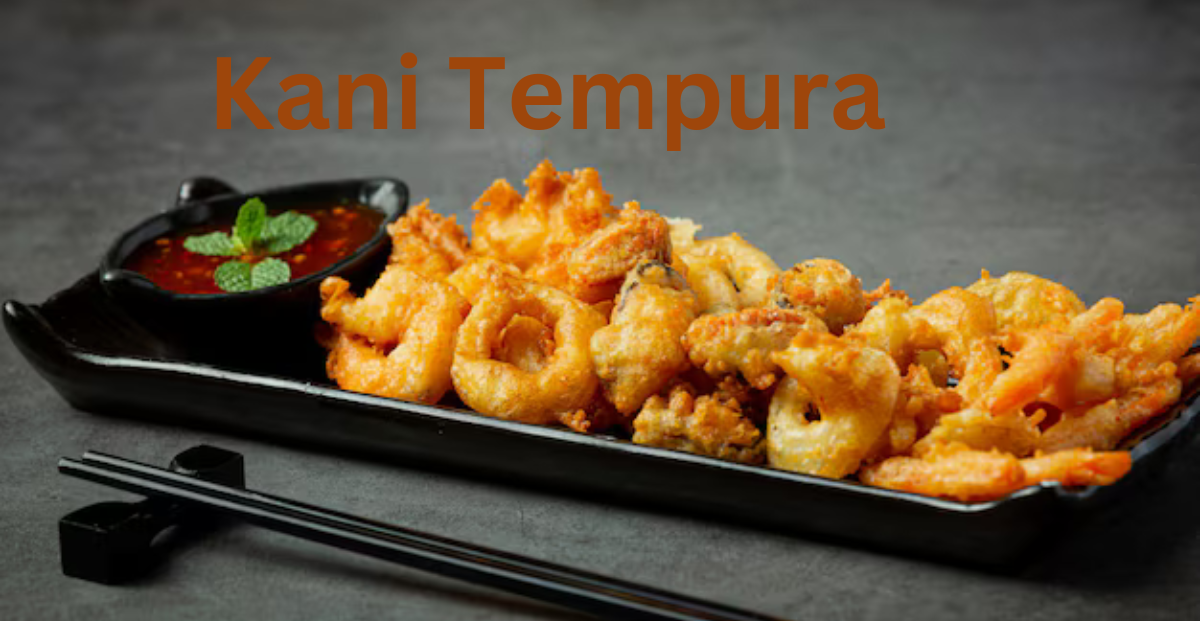Japanese cuisine’s favorite dish, kani tempura, combines the flavorful richness of crab with the airy crispiness of tempura batter. Thanks to its delicious flavor and ease of preparation, this meal has gained popularity all over the world. Kani tempura offers a tasty, gratifying, and distinctive experience, regardless of your level of experience with Japanese cuisine.
This post will explain what kani tempura is, how it’s made, why it’s healthy, and why it’s now a staple at Japanese eateries all over the world. We’ll also address some commonly asked questions concerning this mouthwatering dessert.
What Is Kani Tempura?
Crab flesh that has been lightly battered with tempura and deep-fried till golden crisp is known as kani tempura. “Tempura” is a common cooking method in Japanese cuisine that involves dipping seafood or vegetables in batter and deep-frying them. “Kani” is the Japanese name for crab. The end product is a dish that is crisp and savory, with the inherent sweetness of the crab at its heart.
The Origins of Tempura
It is thought that Portuguese missionaries brought tempura to Japan in the sixteenth century. Since then, it has developed into a traditional Japanese cooking method that makes use of meats, vegetables, and shellfish. A variant of this dish that features crab as the primary ingredient is called kani tempura.
How Kani Tempura Is Made
Although there are a few steps involved in creating kani tempura, they are not too complicated, so if you’re feeling particularly daring in the kitchen, you may easily reproduce the dish at home.
How to Prepare the Crab: While actual crab meat is always an option, many recipes call for imitation crab, or surimi, which is more readily accessible and less expensive. Cleaning and preparing actual crab is crucial if you’re utilizing it.
Tempura Batter: Traditionally, flour, egg, and cold water are combined to make tempura batter. Some cooks increase the batter’s lightness and crispiness by adding a small amount of baking powder. Maintaining the batter’s coolness and avoiding overmixing are crucial for achieving the signature airy and light texture of tempura.
Frying: The crab flesh is cooked in heated oil until golden and crispy after being dipped in the batter. The fast cooking ensures that the outside of the crab gets just the right crunch while the inside stays juicy and tasty.
Serving suggestions: Soy sauce, dashi, and mirin are common ingredients in dipping sauces that are offered with kani tempura. Grated daikon radish is one option that adds a cool contrast to the richness of the tempura.
Why Kani Tempura Is So Popular
Because it’s rich and easily attainable, kaki tempura has grown to be a beloved dish in Japanese eateries. It’s a meal that’s hard to resist because of the combination of sweet crab meat and crunchy batter. It can also be eaten as a topping over rice bowls, part of a sushi roll, or as an appetizer on its own because of its versatility.
Moreover, tempura’s lightness makes it a fantastic choice for people who like fried foods but wish to stay away from heavier, oily meals. Unlike other fried meals, tempura has a unique, light texture that brings out the tastes of the crab.
Health Benefits of Kani Tempura
Despite being fried, kani tempura is still a healthy food choice when included in a balanced diet. Here are some advantages of kani tempura for your health:
High in Protein: Lean protein, which is necessary for tissue repair and muscular building, is abundant in crab meat.
Low in Fat: Compared to other fried dishes, kani tempura is a very light dish since real crab meat has a low fat content.
Rich in elements: Vitamin B12, zinc, and selenium are just a few of the vital elements found in crabs. These nutrients support healthy immune system, brain development, and metabolism.
Omega-3 Fatty Acids: Omega-3 fatty acids are good for the heart and can be found in crab as well.
Although the frying procedure makes kani tempura heavy in calories, it’s still okay to consume it in moderation.
Conclusion
A delicious dish called kani tempura combines the light, crispy texture of tempura batter with the deep, natural flavor of crab. With its delicate mix of flavors and textures, kani tempura never fails to impress, whether you’re eating it as an appetizer or incorporating it into a bigger dinner.
Even though it’s fried, kani tempura has nutritional value, particularly when made with actual crab flesh, which has a high protein content and a low fat content. With its increasing global appeal, kani tempura has established itself as a mainstay of Japanese cooking that will never fail to delight foodies everywhere.
Kani tempura ought to be at the top of your list if you enjoy Japanese cuisine or are just attempting to discover something new to test. Any food aficionado should try it because of its distinctive flavor, texture, and cultural significance. You’re going to be in for a treat whether you choose to make it at home or enjoy it at a restaurant!
FAQs
Which kind of crab is used to make kani tempura?
You can use fake crab (surimi) or actual crab meat to make kani tempura. Since imitation crab is more readily available and less expensive than real crab, it’s a popular substitute that has a more true flavor.
. Is it possible to produce kani tempura at home?
Indeed! Making kani tempura at home is not that difficult. Crab meat, tempura batter, and a deep fryer or frying pan are all you need. The secret to success is to fry the crab flesh until it turns golden and crispy while keeping the batter cool.
How healthy is kani tempura?
Even though kani tempura is fried, when consumed in moderation, it can still be a nutritious food. Compared to other fried dishes, crab meat has less grease because of its light tempura batter and high protein content.
How should kani tempura be served?
A dipping sauce consisting of soy sauce, dashi, and mirin is frequently served with kani tempura. It can also be eaten as a rice bowl topping or added to sushi rolls.
Can I make kani tempura with imitation crab?
Indeed, using imitation crab to make kani tempura is a popular and reasonably priced choice. It tastes and feels just like real crab meat, and you can find it in most grocery stores.










